One salamander, 16 frogs and toads, 5 turtles, 19 lizards, and 26 snake species can be found in Colorado. In the Bear Creek Watershed there is 1 salamander, 4 frogs and toads, 3 turtles, 2 lizards, and 5 snakes.
NOT THE SAME!
Amphibians and Reptiles were once considered to be in the same group zoologically because of their many similarities in appearance. We now know that reptiles are more closely related to birds than to amphibians!
HERPETOLOGY:
The study of reptiles and amphibians is called Herpetology. Animals in the two groups are often referred to as “herps” for short.
HOW THEY ARE ALIKE:
Both rely on external sources to regulate their body temperatures (often called “cold blooded”); both have spinal columns; some members of each group can change color to camouflage themselves or regulate their body temperatures; some of each group can shed their tails and regrow them if caught by the tail by a predator; and some of each group shed their skin as they grow.
HOW THEY ARE DIFFERENT:
Reptiles have scales and are waterproof. They feel dry and scaly to the touch. They must drink water to stay hydrated. Most live on land and breath air. Many live in hot, arid regions. Most lay hard or leathery eggs. A few, like rattlesnakes, give birth. Baby reptiles look like tiny adults.
Amphibians have smooth, porous skin, which is moist and sometimes even sticky. They stay hydrated by absorbing water through their skin. With only a few exceptions, they must stay in moist habitats to survive. Amphibian eggs are soft and jelly like and are laid in water or very moist places. Amphibians spend at least part of their life in a larval stage, in water, breathing through gills before they metamorphize, or transition, from their immature form to their adult form.
Bear Creek Watershed Herps
Salamander
Western Tiger or Barred Salamander (Ambystoma mavortium)

Tiger salamanders are not often seen because they spend most of their time as adults in moist places, including underground or under piles of leaves or rocks. They are most active at night, to avoid predators.
More information and photos: Barred Tiger Salamander (Smithsonian’s National Zoo & Biology Conservation Institute)
Frogs and Toads
Bullfrog (Lithobates catesbeianus)
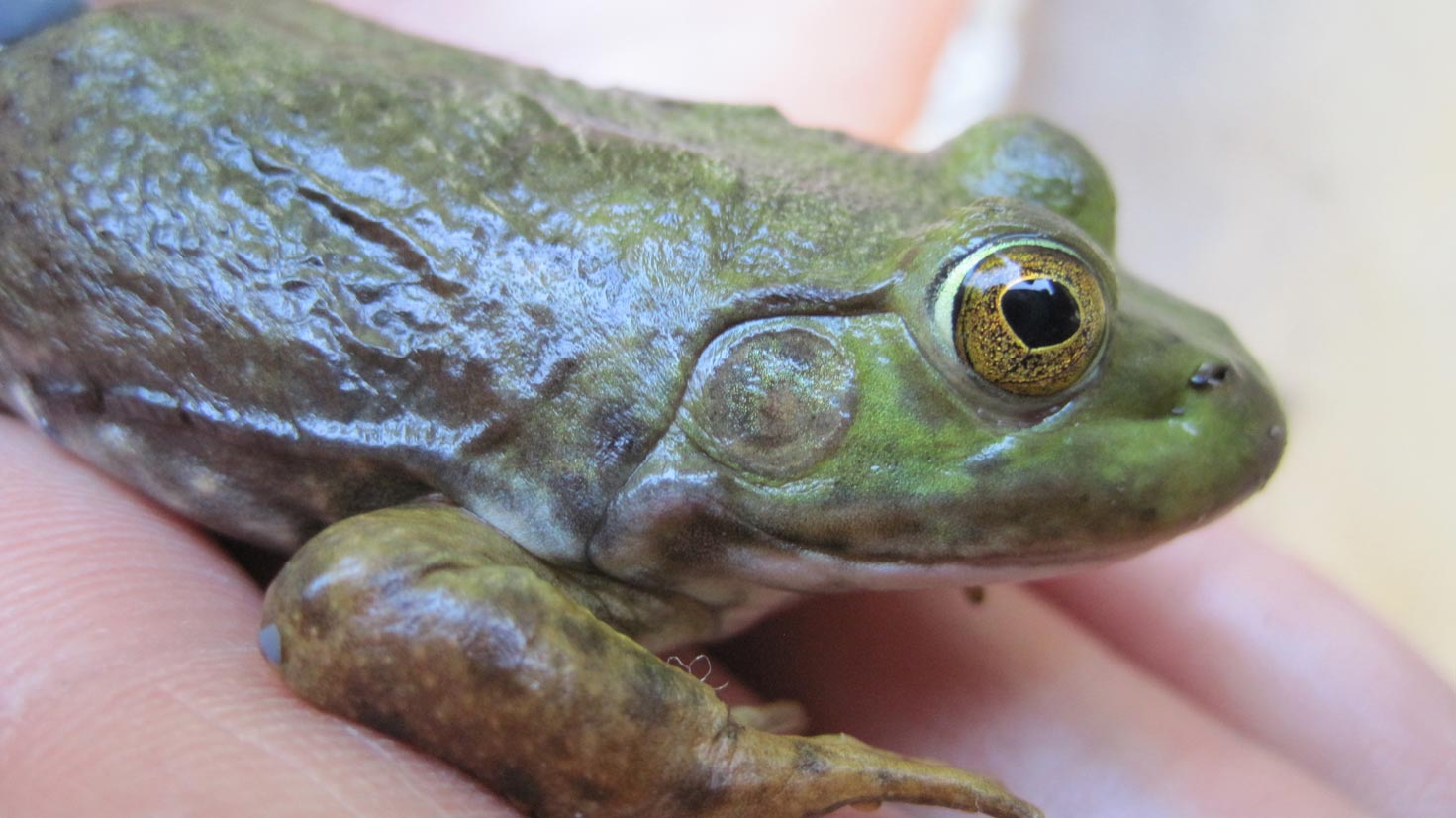
Bullfrogs are not native to Colorado. They are invasive, meaning that they are so successful that they crowd out our native species. Unmistakable because of their size, they can measure 6 inches or more and weigh more than a pound. A male Bullfrog’s croak sounds a little like a bellowing bull, hence the name. They are found just about anywhere there is water but prefer warm, slow, or stagnant water and water with lots of vegetation.
Learn more: American Bullfrog Fact File (Animal Facts)
Northern Leopard Frog (Lithobates pipiens)
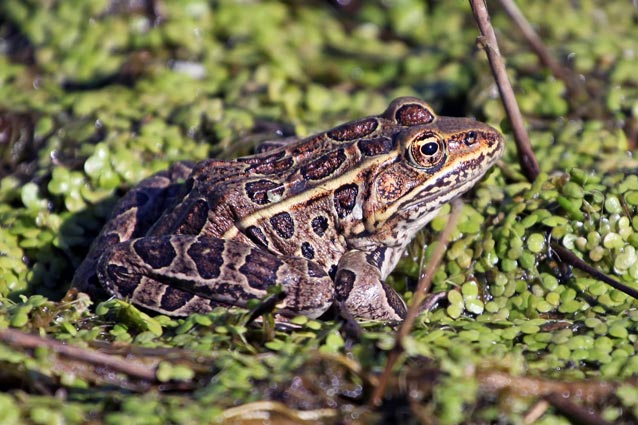
Northern Leopard Frogs have smooth green, brown, or sometimes yellow-green skin, covered with large, oval dark spots. They have white to cream-colored undersides. Leopard frogs grow up to 4.5 inches in length. They are found in or near water, including in wet meadows, springs, farm ponds and even in stock tanks.
Learn more: Northern Leopard Frog (National Park Service)
Western Chorus Frog (Pseudacris triseriata)

Almost impossible to spot, these tiny frogs are only about an inch long and are perfectly camouflaged. You might not see them, but you have probably heard them anywhere there is water, including ephemeral ponds, ditches, wet meadows, and even muddy parking lots. Their “chorus” is a high-pitched trill that starts and stops several times a minute. It is nearly impossible to sneak up on chorus frogs because they feel the slightest vibrations. They immediately stop singing and hide.
Learn more: Green Serenade (New Colorado Naturalist)
Woodhouse’s or Rocky Mountain Toad (Anaxyrus woodhousii)
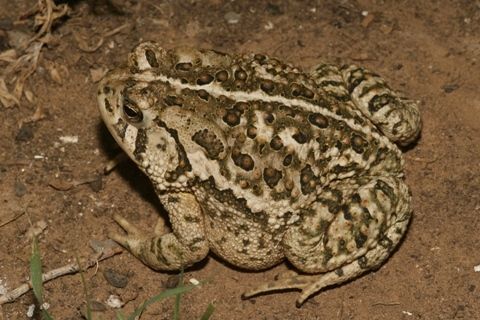
This is our local toad, found throughout the watershed, most frequently near water. Bumpy and warty looking, with white stripes down their backs, these toads can grow up to 4 inches in length. Primarily nocturnal, they especially enjoy hanging out in lighted areas, for example, under streetlights, where there are plenty of tasty insects to be had.
Learn more: Woodhouse’s Toad (Desert USA)
What’s the difference between a frog and a toad? Check it out!
Frogs Vs. Toads: 6 Key Differences & Similarities Everyone Should Know… (Reptile Guide)
Turtles
Snapping Turtle (Chelydra serpentina)

Snapping turtles are found in ponds and lakes and, in spring, they are often seen crossing roads as they look for a nice sandy, sunny spot to lay their eggs. Their jagged shells, which have pronounced ridges, may reach 20 inches in diameter. Snapping turtles keep growing their whole lives. In the wild, adults average around 20 to 25 pounds, but they have weighed-in at 50, even up to a whopping 75 pounds! Snapping turtles are equipped with sharp beaks, very strong jaws, sharp claws, long, prehistoric-looking tails and nasty dispositions.
Learn more: Common Snapping Turtle: Facts, Characteristics, Habitat and More (Animal Place)
Western Painted Turtle (Chrysemys picta)
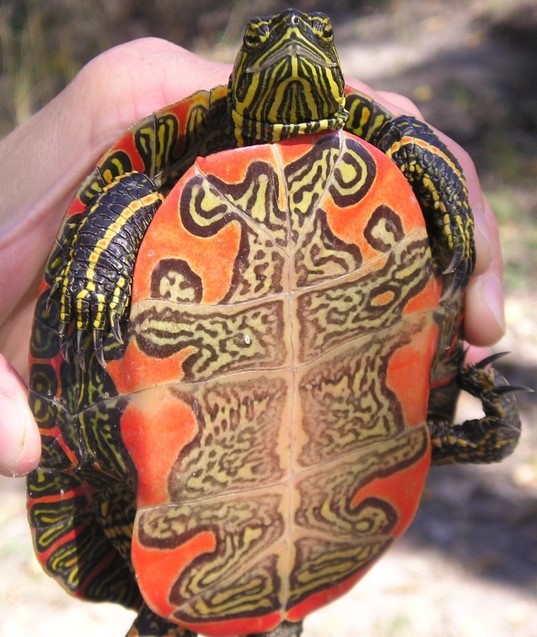
The Western Painted Turtle, Colorado’s state reptile, is Colorado’s most common turtle. Found in slow moving water, Painted Turtles are easy to identify. They have smooth, flattish shells, often fringed in red or orange, and bright orange and yellow markings on their skin. Their plastrons (bottom shells) have beautiful colorful designs on them. Adults rainge in size from about 3 ½ inches to nearly 10 inches in length. Painted turtles are frequently seen sunning on logs or rocks in wetland areas.
Learn more: Western Painted Turtle (Washington Nature Mapping Program)
Red-eared Slider (Trachemys scripta elegans)
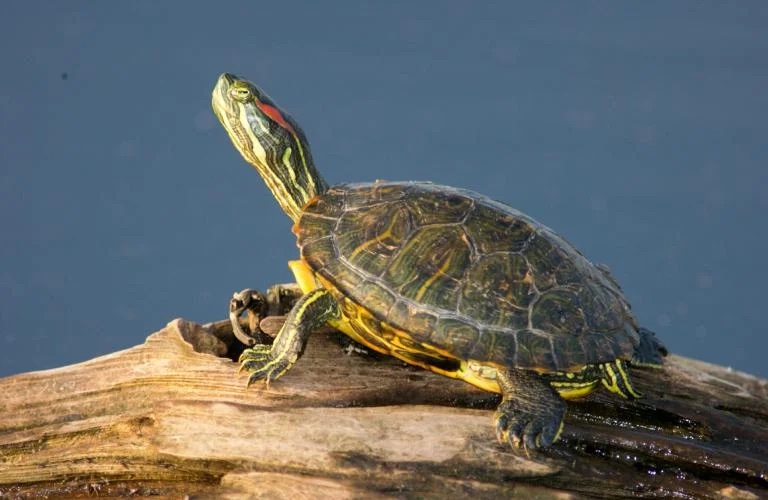
Red-eared Sliders look similar to Painted Turtles, but are told by the red stripe behind their ears, yellow markings on their skin, domed carapaces (upper shells) and the jagged back edges of their shells. Adults grow to be 8 or more inches long, in general a bit smaller that painted turtles. Sliders are not native to Colorado but have been introduced, most likely by people releasing pet turtles. (This is the popular pet turtle sold in pet stores.) Unfortunately, they are thriving and competing with native species.
Learn more:
- Red Eared Slider (Animals Network)
- Red-Eared Slider (Colorado PARC)
Western Painted Turtles and Red-eared Sliders can easily be mistaken for each other. Here is information about telling them apart:
- Painted Turtle vs Red-eared Slider (Washington Nature Mapping Program)
- Native Turtles of Colorado (with Pictures) (TurtleOwner.com)
- Are there turles in Colorado? (Crittering)
Lizards
Prairie Lizards (Sceloporus Consobrinus)

Prairie lizards, common throughout the watershed, are your stereotypical small lizards. They have relatively large, rigid scales ranging in color from light gray to brown and with a wide, dark gray stripe down the middle of the back framed by paler stripes on either side. Adults range from 4.5-7 inches long. They are found in grassy areas with sandy soils and sparse vegetation and in rocky habitats including cliffs, talus fields, canyons, hogbacks, and various outcroppings as well as in basements and on porches and decks. They like to sun themselves on rocks and are also found in trees and piles of construction debris, on wood piles and sides of buildings, and on bare dirt along roadsides or construction sites.
More information: Prairie Lizard (Colorado PARC)
Six-Lined Racerunners (Aspidoscelis sexlineatus)
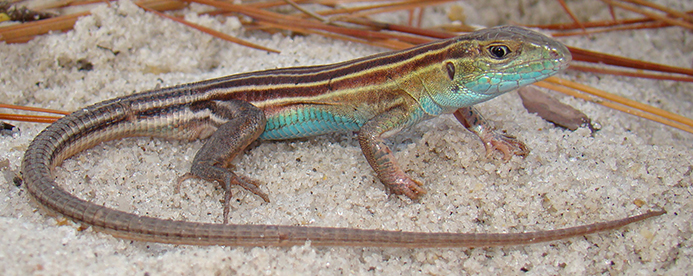
Six-Lined Racerunners are found in fields and open woodlands in the lower reaches of the watershed. They prefer sunny areas with dry, eroded clay and sandy soils. They have black, brown or olive skin that appears to be velvety (versus shiny or scaly) with 6 or 7 lighter colored, longitudinal stripes. Full grown adults are about 10 inches long from nose to tail. They are very fast and hard to spot, quickly hiding from predators and curious on-lookers in long grass or burrows.
Snakes
Go to the CU Boulder Museum of Natural History website for excellent photos and descriptions of Colorado’s snakes.
Garter Snakes (Thamnophis)

There are five, possibly more species of garter snakes in Colorado and two or three of them may be found in the watershed. Garter snakes are slim, medium-sized snakes that range in color from dark grey to light brown. They all have longitudinal stripes along sides of their bodies and pale, unmarked bellies. These harmless snakes can grow to nearly 50 inches but are usually much shorter.
Bull Snake or Gopher Snake (Pituophis catenifer)
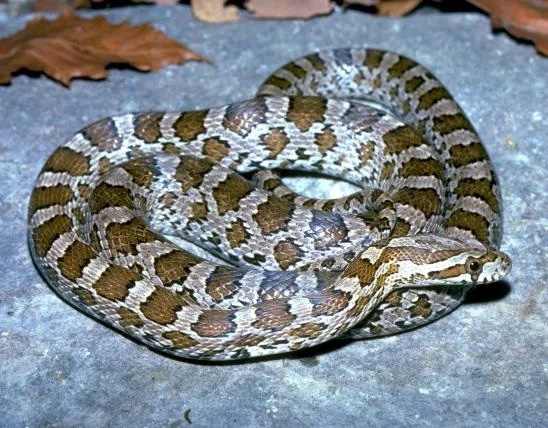
Bull snakes are large snakes, which can grow to be more than 70 inches long. They are found at elevations up to about 8,500 feet but are more common below 7,000 feet. They are yellowish or cream colored with dark brown blotches on their bodies that are more like stripes near their tails. Generally harmless to people, they can act aggressive, making a deep sound sort of like a bull’s moo (hence the name) if disturbed. While they are usually secretive and tend to hide in ground cover or underground burrows, they are excellent climbers and are sometimes found in bushes and high in trees.
Prairie Rattlesnake (Crotalus viridis)
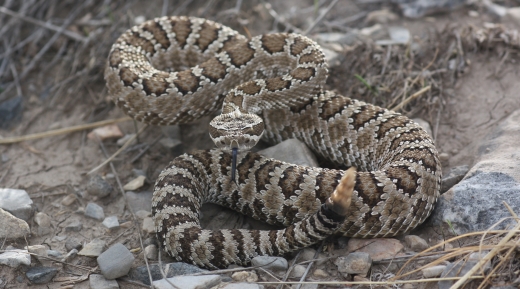
Found in all habitats in the lower reaches of the watershed below about 6,500 feet, these are venomous snakes to avoid. They may be seen sunning themselves on trails and on rocks and they often hide in rock crevices, woodpiles, brushy vegetation and in abandoned burrows of other animals. Rattlesnakes are identified by their broad, triangular-shaped heads and, at the other end, horny rattles on the tips of their tails which they shake when threatened. They have heat sensing pits on both sides of their heads, below the eyes, and vertically elongated pupils like a house cat. They are pale brown with darker brown blotches. Mature snakes here grow to about 25 or 26 inches.
Seek medical help immediately if bitten by a rattlesnake.
North American Racer or Yellow Bellied Racer (Coluber constrictor)

Racers are fast-moving, agile snakes found in prairie grasslands, open riparian woodlands, shrubby foothills, canyons and in the edges of agricultural areas. They are usually stay on the ground and hide in rodent burrows and in spaces under rocks when threatened or resting, but they can and do climb into shrubs and small trees. They are smooth, plain brown or olive colored with yellow or cream-colored bellies and relatively large eyes. Adults can be 22 to 32 inches long.
Milk Snakes (Lampropeltis Triangulum)

Milksnakes are unmistakable with their smooth skin and bright black, white, and red bands which are separated by narrow cream or light-yellow bands. They are found in prairie, canyon, rocky slope, ponderosa pine and pinon-juniper ecosystems, below 8,000 feet. Adults may be 24-35 inches. They are slow moving and generally non-confrontational, secretive, and primarily nocturnal. They are called milk snakes because they are often found near barns and it was once thought that they drank cow’s mild straight from the udder. In fact, they are not physically able to milk cows this way but barns provide good places for them to hide and a steady supply of mice for food.
Go to Colorado Herping for more information and for help identifying snakes.
References and Resources
- Quick Key to Amphibians and Reptiles of Colorado (PDF, Colorado Parks and Wildlife)
- Species Profiles (Colorado Parks and Wildlife)
- Colorado Herping
- Snakes of Colorado (CU Boulder Museum of Natural History)
- Colorado Herpetological Society
- Colorado Partners Amphibian and Reptile Conservation
- The Jungle Lady – excellent photos and descriptions
- The Frog Lady – includes recordings and great photos of Colorado’s frogs